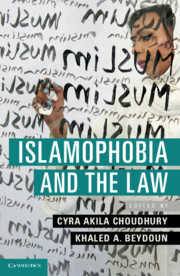Book contents
- Islamophobia and the Law
- Islamophobia and the Law
- Copyright page
- Contents
- Note on Contributors
- Acknowledgments
- Introduction
- Part I Race and Citizenship
- Part II The Politics of Islamophobia in the Courts
- Part III Islamophobia in Criminal Law and National Security Law
- Part IV Law, Society, and Islamophobia
- 11 Property Lawfare: Historical Racism and Present Islamophobia in Anti-Mosque Activism
- 12 “Liberty and Death”
- 13 The Gender of Islamophobia
- 14 Coercive Assimilationism and Muslim Women’s Identity Performance in the Workplace
- Index
13 - The Gender of Islamophobia
from Part IV - Law, Society, and Islamophobia
Published online by Cambridge University Press: 29 September 2020
- Islamophobia and the Law
- Islamophobia and the Law
- Copyright page
- Contents
- Note on Contributors
- Acknowledgments
- Introduction
- Part I Race and Citizenship
- Part II The Politics of Islamophobia in the Courts
- Part III Islamophobia in Criminal Law and National Security Law
- Part IV Law, Society, and Islamophobia
- 11 Property Lawfare: Historical Racism and Present Islamophobia in Anti-Mosque Activism
- 12 “Liberty and Death”
- 13 The Gender of Islamophobia
- 14 Coercive Assimilationism and Muslim Women’s Identity Performance in the Workplace
- Index
Summary
Since September 11, a critical mass of scholarship has documented how American politicians mobilized the image of marginalized Muslim women and sexual minorities to signal of the backwardness of Islam. In this imagined world of bad Muslims and good Americans, the United States emerges as a bastion of freedom and liberty for women and for lesbian, gay, bisexual, and transsexual (LGBT) people while Muslim people remain unfree, isolated, and oppressed.1 The campaign and election of Donald Trump in 2016 unleashed a new onslaught of anti-Muslim sentiment as Trump mobilized anti-Muslim tropes while still a candidate. As president, he held true to his campaign promises to limit the entry of Muslims into the United States with a series of executive orders and, finally, a proclamation commonly known as the “Muslim ban.”2 Drawing on the critique of gendered tropes about Islam, this chapter argues that the Trump administration benefited from the use of gendered ideas about Muslims set into motion by prior administrations in order to justify anti-Muslim lawmaking. In making this argument, this chapter provides an overview of the rich feminist and queer debates on Islam, gender, sex, and sexuality, which have critiqued both Republican and Democratic administrations for their participation in the vilification Muslims and Arabs on gendered grounds and helped justify both the “never-ending” War on Terror and anti-Muslim lawmaking in the United States.
- Type
- Chapter
- Information
- Islamophobia and the Law , pp. 249 - 260Publisher: Cambridge University PressPrint publication year: 2020
- 1
- Cited by



